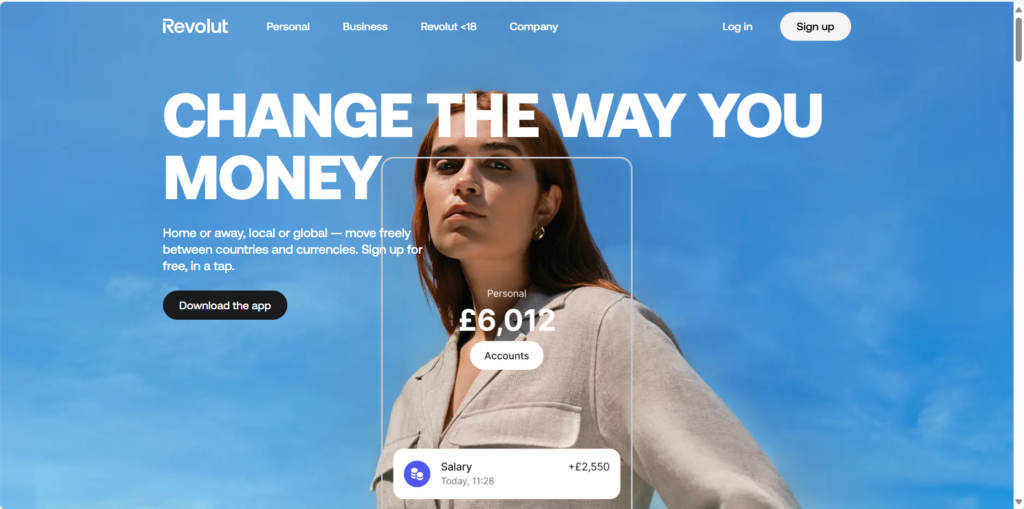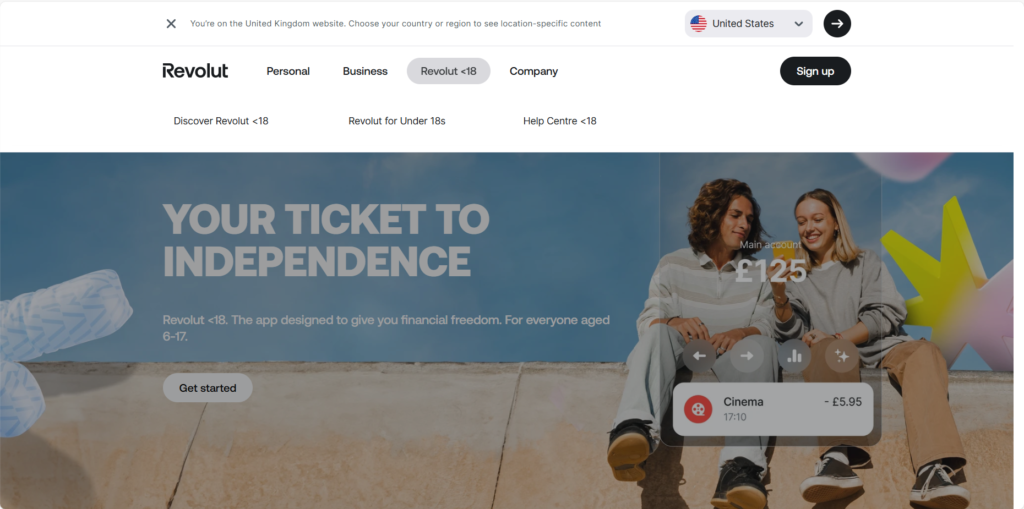Introduction
Founded in 2015, Revolut has disrupted the fintech industry with bold marketing strategies and digital-first experiences. The company has grown into a global financial powerhouse by attracting millennials and Gen Z users with convenient and appealing money management features. From travel benefits to cryptocurrency trading, Revolut positions itself as a modern alternative to traditional banks.Revolut’s marketing is as innovative as its products. The brand resonates with younger audiences through social media, referral rewards, and localization strategies, driving business growth. By combining product innovation with relatable, engaging communication, Revolut has built a loyal customer base globally.This article explores the strategies behind Revolut’s marketing success and the lessons marketers can learn from how Revolut connects with its audience and builds its global brand.

1. Targeting Millennials and Gen Z
Revolut’s success is deeply rooted in understanding younger generations’ values and lifestyles. Millennials and Gen Z value convenience, transparency, and technology-driven solutions—elements that Revolut seamlessly incorporates into its products.The company’s marketing focuses on features that resonate with these audiences, such as fee-free currency exchange, cryptocurrency trading, and budgeting tools. Campaigns frequently highlight travel benefits like free international ATM withdrawals and no foreign transaction fees to appeal to young customers’ enthusiasm for travel.Revolut’s brand style is fresh and relatable, avoiding the stiff tone of traditional banks. Advertisements and social media posts speak directly to their audience, addressing pain points while emphasizing how Revolut simplifies financial management.What you can learn:
- Understand your audience: Identify what your core demographic values most and align your messaging with their priorities.
- Use their language: Employ an authentic tone and style relevant to your target audience.
By focusing on what matters most to millennials and Gen Z, Revolut has created a modern, approachable, and indispensable brand image.
2. Product-Led Growth (PLG)
Revolut relies heavily on its product to drive growth, a strategy known as product-led growth (PLG). Rather than using flashy advertisements or exaggerated promotional campaigns, the company emphasizes its innovative features to attract and retain customers.Key products like cryptocurrency trading, virtual cards, and instant budgeting tools are central to Revolut’s marketing. The philosophy is simple: let the product speak for itself. By showcasing the actual value of the product, such as saving on currency exchange fees or tracking spending in real-time, Revolut builds trust and encourages organic growth.For example, Revolut’s product launch campaigns typically focus on demonstrating how its tools solve specific financial problems. This clear, benefit-oriented approach resonates with users seeking practical solutions for everyday money management.What you can learn:
- Let your product market itself: Highlight your product’s unique benefits in your marketing.
- Solve real problems: Position your product as a solution to common customer pain points.
Revolut’s product-led approach shows that when your product delivers genuine value, it becomes your most powerful marketing tool.
3. Referral and Incentive Programs
Revolut has mastered the art of viral growth through its effective referral and incentive programs. The company encourages users to invite friends by offering rewards like cash bonuses or free premium features. This approach transforms existing users into brand advocates. By rewarding both the referrer and the new customer, Revolut creates a win-win situation that incentivizes word-of-mouth promotion. This not only lowers customer acquisition costs but also fosters trust, as referrals typically come from friends or family.Additionally, Revolut gamifies its incentive mechanisms. Progress bars and exclusive tiers encourage users to invite more people to unlock bigger rewards. These elements make the referral process more appealing and interactive, increasing engagement.What you can learn:
- Design engaging referral programs: Make it easy and rewarding for customers to recommend your brand.
- Gamify incentives: Use elements like progress bars or levels to make referrals more exciting.
Revolut’s referral strategy proves that satisfied customers can become your most powerful marketing channel when properly incentivized.

4. Large-Scale Localized Marketing
Revolut’s global success stems from its ability to adapt marketing strategies to local markets. Operating in over 200 countries, Revolut tailors campaigns to different regional audiences, ensuring its messaging aligns with local cultures and preferences.For example, in Europe, Revolut emphasizes travel benefits like fee-free currency exchange and international card usage to cater to frequent travelers in the region. In contrast, marketing campaigns in Asia focus more on features like cryptocurrency trading and virtual cards, which are particularly popular there.Revolut also uses localized advertisements in multiple languages and collaborates with influencers and brands familiar to specific markets. This approach allows the company to build deeper connections with its audience, fostering trust and engagement across different populations.What you can learn:
- Tailor your marketing campaigns: Adapt your messaging to match the unique needs and values of different markets.
- Localize visuals and language: Use images and wording that resonate with specific regions to make your campaigns more personalized.
Revolut’s localized marketing strategy demonstrates the power of adapting and connecting locally while expanding globally, a key approach for scaling any brand.
5. Engagement Through Social Media and Content
Revolut has built a strong presence on social media by adopting a witty, relatable tone and engaging directly with its audience. Whether announcing new features, answering user questions, or sharing money management tips, Revolut’s social content comes across as approachable and human.The company is particularly active on platforms like Twitter and Instagram, connecting with young audiences through humor and timely references to trending topics. For instance, Revolut shares memes about budget struggles and lighthearted tweets about saving money, making financial topics less intimidating.Revolut also transforms customer feedback into content. Posts highlighting user success stories or addressing common questions enhance trust and transparency. This two-way communication reinforces Revolut’s customer-centric brand image.What you can learn:
- Stay approachable: Use a genuine tone that matches your audience’s humor and style.
- Engage actively: Respond to questions, feedback, and comments to foster a sense of connection and trust.
Revolut’s social media strategy shows that engaging, human-centered content can make complex topics like finance approachable and interesting.
6. Leveraging Data and Personalization
Revolut uses data-driven insights to create highly personalized experiences for its users. By analyzing spending habits, transaction history, and user preferences, the company offers tailored recommendations and tools that enhance financial management.For instance, Revolut provides users with spending breakdowns, clearly showing how much they’re spending on categories like groceries, travel, and entertainment. It also sends real-time transaction notifications, keeping users informed and in control of their finances. Additionally, personalized budgeting tools allow users to set goals and track progress, empowering them with a sense of control.This data-driven personalization extends to Revolut’s marketing as well. Targeted marketing campaigns based on user behavior ensure customers see relevant features and offers, increasing engagement and retention rates.What you can learn:
- Use data to personalize experiences: Customize tools, notifications, and marketing campaigns to meet customers’ specific needs.
- Empower your users: Provide actionable insights that help customers make informed decisions.
Revolut’s approach shows that personalization isn’t just a nice-to-have feature but an effective way to build loyalty and enhance customer satisfaction.
Conclusion
Revolut’s innovative marketing strategies showcase how a brand can disrupt a traditional industry and build meaningful connections with its audience. From attracting millennials and Gen Z through relatable messaging to leveraging referrals, personalization, and localization strategies, Revolut has created a modern, approachable, and indispensable global brand.Key takeaways:
- Understand your audience: Focus on the values and needs of your target demographic.
- Make your product the star: Highlight how your product solves real problems for customers.
- Leverage incentives: Use referral and gamification strategies to encourage growth.
- Think global, act local: Adapt your campaigns to resonate with different markets.
- Engage authentically: Build trust through relatable, human-centered communication.
- Personalize comprehensively: Use data-driven insights to create tailored experiences that keep customers engaged.
Revolut’s success proves that combining product innovation with customer-centric marketing can create a winning formula. Draw inspiration from their strategies to craft your own high-impact campaigns that drive growth.